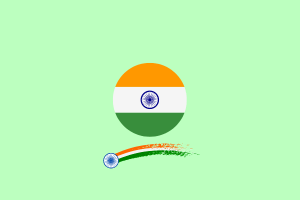Studying in India from Nepal
Introduction to India
India is a diverse and vibrant country known for its rich cultural heritage and rapidly growing economy. The official language of India is Hindi, although English is widely spoken and used for official and educational purposes. The capital city is New Delhi, a bustling metropolis that serves as the political and administrative hub of the country. India has a population of over 1.4 billion people, making it the second most populous country in the world. It shares borders with several countries, including Pakistan, China, Nepal, Bhutan, Bangladesh, and Myanmar. The country’s per capita income is approximately USD 2,000, reflecting its status as a developing economy with significant regional disparities.
Top Universities in India
India is home to many prestigious universities that attract international students, including those from Nepal. Here are five of the top-ranked universities in India:
1. Indian Institute of Technology (IIT) Bombay: Renowned for its engineering and technology programs, IIT Bombay consistently ranks as one of India’s top institutions.
2. Indian Institute of Science (IISc) Bangalore: Specializing in research and higher education in science and engineering, IISc is one of the most prestigious institutions in India.
3. Indian Institute of Technology (IIT) Delhi: Another top-tier engineering institute, IIT Delhi offers a range of undergraduate and postgraduate programs.
4. University of Delhi: One of the largest and oldest universities in India, it offers a variety of courses in humanities, sciences, and social sciences.
5. Jawaharlal Nehru University (JNU): Known for its research-oriented approach, JNU offers excellent programs in social sciences, international studies, and sciences.
Visa Application Process
To study in India, Nepalese students need to obtain a Student Visa. The application process involves several steps:
1. Acceptance from an Indian University: Students must first secure admission to a recognized Indian university or institution. This typically requires meeting the admission criteria, which may include entrance exams, interviews, and submission of academic documents.
2. Visa Application: After receiving an acceptance letter, students can apply for a Student Visa at the Indian Embassy or Consulate in Nepal. The application form is available online on the Indian Ministry of Home Affairs website.
3. Required Documents: The following documents are generally required:
- Passport with a minimum validity of six months
- Recent passport-sized photographs
- Admission letter from the Indian institution
- Proof of financial support
- Completed visa application form
- Proof of residence in Nepal
4. Visa Interview: Some applicants may be required to attend a visa interview.
5. Processing Time: The processing time for a Student Visa varies but typically takes about 4-6 weeks.
Student Visa Application Fee
The Student Visa application fee for Nepalese students varies depending on the duration of the course and the type of visa. Generally, the fee ranges from USD 75 to USD 150. It’s advisable to check the latest fee structure on the Indian Embassy’s website or contact the embassy directly for accurate information.
Why India is Popular Among Nepalese Students
India is a popular destination for Nepalese students for several reasons:
1. Cultural and Geographical Proximity: India and Nepal share cultural ties and geographical proximity, making it easier for students to adapt to the environment.
2. Quality Education: Indian universities offer quality education, particularly in fields like engineering, medicine, and management, at a fraction of the cost compared to Western countries.
3. Affordability: The cost of living and tuition fees in India are relatively lower, making it an affordable option for many Nepalese families.
4. Diverse Opportunities: India offers a wide range of courses and programs, giving students various academic and career opportunities.
5. Ease of Travel: The close proximity allows for easier travel between the two countries, making it convenient for students to visit home during vacations.
Post-Study Work Visa Opportunities
India offers several opportunities for international students to gain work experience after completing their studies. While the country does not have a specific post-study work visa like some Western countries, students can apply for internships, training programs, or employment through the following routes:
1. Internships: Many universities and institutions in India have tie-ups with companies offering internships to students. These can sometimes lead to full-time employment.
2. Employment Visa: International graduates can apply for an Employment Visa if they secure a job offer from an Indian company. The visa requirements include a minimum salary threshold and a job role that requires specialized skills.
3. Entrepreneurship: India also encourages entrepreneurship, and students can explore setting up their own ventures.
Popular Fields of Study in India
Indian universities offer a wide array of courses, but some of the most popular fields among Nepalese students include:
1. Engineering and Technology: With world-renowned institutions like IITs, engineering remains a top choice.
2. Medicine: India offers quality medical education at a reasonable cost.
3. Management and Business Studies: MBA programs in India are well-regarded and provide good career prospects.
4. Information Technology: With the growing IT industry, courses in computer science and IT are highly sought after.
5. Humanities and Social Sciences: Universities like JNU offer strong programs in these areas.
Average Living Cost in Major Indian Cities
The cost of living in India varies significantly depending on the city and lifestyle. Here are average monthly expenses in five major Indian cities:
1. Mumbai: INR 30,000 50,000 (USD 400 700)
2. Delhi: INR 25,000 45,000 (USD 330 600)
3. Bangalore: INR 25,000 40,000 (USD 330 530)
4. Chennai: INR 20,000 35,000 (USD 270 470)
5. Hyderabad: INR 20,000 35,000 (USD 270 470)
These costs include accommodation, food, transportation, and other basic expenses.
Dependent Policy
According to Indian immigration policies, international students are allowed to bring their dependents (spouse and children) on a Student Visa. However, dependents are not allowed to work in India unless they obtain a separate Employment Visa. Students must provide proof of financial stability to support their dependents during their stay.
Permanent Residency (PR) and Citizenship for Foreign Students
India does not offer a straightforward path to permanent residency (PR) or citizenship for international students. However, students can apply for employment visas if they secure a job after completing their studies. Long-term residency can be pursued through employment, business, or marriage to an Indian citizen. Citizenship is generally not granted to foreigners unless under exceptional circumstances or through the naturalization process, which requires a continuous stay in India for at least 12 years.
GAP Acceptance for Bachelor’s and Master’s Degrees
Indian universities generally accept students with educational gaps, provided they meet the admission criteria and provide valid reasons for the gap. For bachelor’s degrees, a gap of up to two years is usually acceptable, while for master’s programs, a gap of up to five years is considered, depending on the course and institution.
Advantages of Studying in India for Nepalese Students
1. Cultural Similarity: Nepal and India share many cultural similarities, making it easier for students to adjust to life in India.
2. Quality Education at Affordable Costs: Indian universities offer high-quality education at relatively lower costs, making it an attractive option for Nepalese students.
3. Diverse Course Offerings: From engineering to humanities, Indian institutions offer a wide range of courses to choose from.
4. Language: English is widely used in Indian academia, making it easier for Nepalese students to follow courses and communicate.
5. Growing Economy: India’s growing economy provides numerous opportunities for internships, part-time work, and post-study employment.
6. Convenient Travel: The geographical proximity allows students to easily travel between Nepal and India, reducing travel costs and time.
Diplomatic Relations and International Affiliations
India and Nepal share a strong diplomatic relationship, with embassies in each other’s capitals. The Indian Embassy is located in Kathmandu, Nepal, while the Nepalese Embassy is in New Delhi, India. Both countries are members of the South Asian Association for Regional Cooperation (SAARC), which promotes regional cooperation and development. India is not a member of NATO, the EU, or the Schengen Area but maintains strong bilateral relationships with many countries and international organizations.
In conclusion, India offers a rich and diverse educational experience for Nepalese students. Its affordable and quality education, cultural proximity, and vibrant student life make it an attractive destination for higher education. With numerous top-ranked universities and a wide range of courses, India provides ample opportunities for personal and academic growth.

